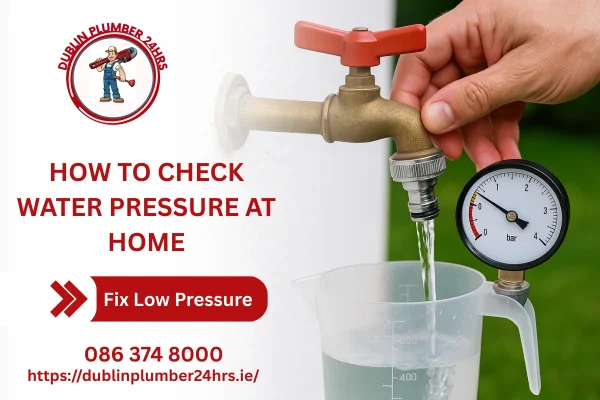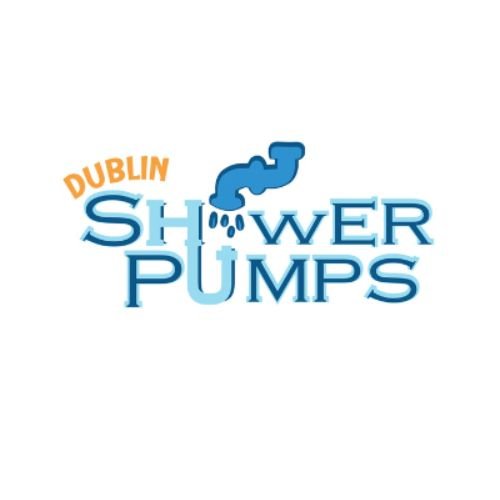How to check water pressure: Attach a gauge to an outdoor tap or use a 1-litre jug test to measure flow rate. Ideal household water pressure ranges between 1 and 3 bar, ensuring efficient plumbing performance and steady flow. Readings outside this range may indicate supply or valve issues that require adjustment. According to Irish Water, maintaining correct pressure prevents pipe damage and supports efficient water use. (Source: Irish Water – “Water Pressure in Homes”)
How to Check Water Pressure at Home: A Simple Guide
Most Dublin homes work best with water pressure between 1 and 3 bars, according to Irish Water guidelines. At Dublin Shower Pumps, we make it easy to test and understand your home’s pressure levels using simple, accurate methods. Whether your shower feels weak or your taps surge too strongly, checking pressure is the first step to keeping your plumbing healthy and your showers consistent.

What Is Water Pressure?
Water pressure refers to the force that pushes water through your pipes and out of your taps and showerheads. It’s measured in bars, with most homes in Ireland needing between 1 and 3 bars for everything to work smoothly. Too low, and your shower might feel more like a drizzle. Too high, and you could be putting unnecessary strain on your plumbing and shower pump.
If your water pressure isn’t in the right range, it can affect everything from your shower experience to how long it takes to fill the washing machine. Understanding what’s normal makes it easier to spot when something’s off.
In Ireland, household water pressure varies depending on your location, elevation, and the local mains network. Irish Water notes that properties in higher areas of Dublin often experience slightly lower pressure than those at street level. Regular testing helps you spot small issues early, preventing strain on your shower pump and ensuring steady flow across all fixtures.
Signs Your Water Pressure May Be Off
Not sure if you need to test your water pressure? Keep an eye out for these common signs:
Weak water flow: If your shower suddenly feels underwhelming or your taps take forever to fill a sink, you might have low pressure.
Excessive force: On the flip side, water blasting out too hard can also be a sign of high pressure.
Noisy pipes or rattling sounds: Unusual noises when using water could point to pressure fluctuations.
Inconsistent flow: Pressure that changes from strong to weak during a shower or while using appliances is a red flag.
If your shower pump is acting up with odd sounds even when not in use, it could be pressure-related. Have a look at our guide on shower pump making noise when not in use to see what might be causing it.
How to Check Water Pressure at Home
Checking your water pressure at home is easier than you might think. Here are two methods you can try:
Method 1: How to Measure Water Pressure with a Gauge
1. Turn off all taps and appliances that use water.
2. Attach a pressure gauge to an outdoor tap or kitchen tap (you may need an adapter).
3. Turn the tap on fully.
4. Read the gauge — most homes should be between 1 and 3 bars.
Method 2: How to Test Water Pressure Without a Gauge (Jug & Timer Method)
1. Take a 1-litre measuring jug and place it under your kitchen tap.
2. Turn the cold tap on full.
3. Time how long it takes to fill the jug.
• Less than 6 seconds = good pressure
• More than 10 seconds = pressure may be too low
How to Check Water Pressure – Quick Steps
1️⃣ Turn off all taps and appliances that use water.
2️⃣ Attach a pressure gauge to an outdoor tap (or use a 1-litre jug test).
3️⃣ Turn on the tap fully and read the result — most Dublin homes should show 1–3 bar.
4️⃣ Contact a professional if the pressure is below 1 bar or above 3 bar.
💧 Recommended Water Pressure Range
Most Irish homes operate best between 1 bar (low) and 3 bar (optimal) of pressure.
Anything below 1 bar may cause weak flow, while over 3 bar can strain pipes and fittings.
What to Do If the Pressure Is Too Low or Too High
If your test shows water pressure that’s either too low or too high, it’s best not to ignore it—both can affect your plumbing and appliances.
Low Pressure
Low pressure can result from:
Blocked pipes or valves
Issues with your mains supply
An undersized or faulty pump
Installing a shower pump is often an effective way to boost pressure, especially for upstairs bathrooms or power showers. It improves flow without overloading your system.
High Pressure
While strong flow might seem like a good thing, water pressure that’s too high can wear out pipes, fittings, and appliances over time. A pressure-reducing valve or system balancing might be needed.
Managing pressure isn’t just about comfort—it can help save energy too. For example, if you’re constantly turning up your electric shower to compensate for poor flow, you’re likely using more energy.
To understand how pressure levels affect your bills, take a look at our guide on energy efficiency and shower pumps.
How Often Should You Check Water Pressure?
It’s best to test your water pressure every few months, or anytime you notice changes in flow or noise. Early checks can prevent long-term pump wear and reduce the risk of airlocks or leaks.
Preventing Common Shower Pump Issues
Maintaining steady water pressure not only keeps your showers consistent—it also helps prevent common pump problems. Sudden drops or air in the system can cause a pump to run dry or make loud noises.
One of the most frequent issues we deal with is airlocks, which can happen when air gets trapped in the pipes and restricts flow. This often leads to noise or your pump cutting out.
The good news? It’s preventable. For a quick guide, visit our page on how to prevent airlocks in the shower pump.
A well-maintained system with balanced pressure reduces the chance of wear and keeps your pump running smoothly for years.
When to Call the Professionals
While a quick test can help you spot pressure problems, some issues need more than a DIY fix. If your water pressure is far outside the normal range, or if you’ve tried adjusting things without success, it’s time to bring in a professional.
At Dublin Shower Pumps, we help homeowners across Dublin get consistent water flow with expert diagnosis, installation, and repair services. Whether it’s replacing a faulty pump, balancing your system, or finding the source of a pressure issue, we’re ready to help.
Getting the pressure right doesn’t just improve your shower—it also protects your plumbing and saves you from future repair costs. If you’re unsure where to start, we’re happy to talk you through it.
Conclusion
Knowing how to check water pressure is a simple but important part of maintaining a reliable and comfortable home water system. A few minutes of testing can tell you if things are running as they should—or if it’s time to take action.
Low or high water pressure can affect everything from your morning routine to your energy bills. By staying on top of it, you help your shower pump work efficiently and extend its lifespan.
If you need advice or hands-on help, don’t hesitate to reach out to us at Dublin Shower Pumps. We’re here to make sure your water pressure—and your shower—are just right.
Frequently Asked Questions (FAQ)
You can use a pressure gauge on a tap or do a quick jug test. A gauge gives the most accurate reading, but timing how fast a 1-litre jug fills also works.
Use the jug method: place a 1-litre jug under a cold tap, turn it on fully and time it. Less than 6 seconds = good pressure. More than 10 seconds = low pressure.
Most homes run best between 1 and 3 bar. Below 1 bar often means weak flow; above 3 bar can cause noise, leaks, or damage.
It could be closed valves, clogged filters, airlocks, a faulty pump, or issues with the mains supply.
Yes. High pressure wears out pipes and fittings, can make them noisy, and may cause leaks. A pressure-reducing valve helps if it’s too high.
Once a year is enough for most homes. Check sooner if you notice weak flow, noise in the pipes, or after plumbing work.
If pressure stays outside 1–3 bar, if DIY checks don’t help, or if you have recurring flow problems, call a qualified installer for a proper fix.
Need to Fix Low Water Pressure in Dublin?
If your shower flow is weak, taps are slow to fill, or pipes are rattling — it’s time to act. At Dublin Shower Pumps, we provide fast, reliable service across Dublin, including diagnosis, pump installation, and pressure adjustments.
Call us today or send a quick message to book a consultation.
Let’s get your water pressure back on track so your shower works like it should.

